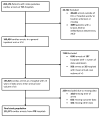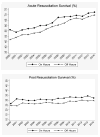Trends in Survival After In-Hospital Cardiac Arrest During Nights and Weekends
- PMID: 29389356
- PMCID: PMC5858924
- DOI: 10.1016/j.jacc.2017.11.043
Trends in Survival After In-Hospital Cardiac Arrest During Nights and Weekends
Abstract
Background: Survival after in-hospital cardiac arrest (IHCA) is lower during nights and weekends (off-hours) compared with daytime during weekdays (on-hours). As overall IHCA survival has improved over time, it remains unknown whether survival differences between on-hours and off-hours have changed.
Objectives: This study sought to examine temporal trends in survival differences between on-hours and off-hours IHCA.
Methods: We identified 151,071 adults at 470 U.S. hospitals in the Get with the Guidelines-Resuscitation registry during 2000 to 2014. Using multivariable logistic regression with generalized estimating equations, we examined whether survival trends in IHCA differed during on-hours (Monday to Friday 7:00 am to 10:59 pm) versus off-hours (Monday to Friday 11:00 pm to 6:59 am, and Saturday to Sunday, all day).
Results: Among 151,071 participants, 79,091 (52.4%) had an IHCA during off-hours. Risk-adjusted survival improved over time in both groups (on-hours: 16.0% in 2000, 25.2% in 2014; off-hours: 11.9% in 2000, 21.9% in 2014; p for trend <0.001 for both). However, there was no significant change in the survival difference over time between on-hours and off-hours, either on an absolute (p = 0.75) or a relative scale (p = 0.059). Acute resuscitation survival improved significantly in both groups (on-hours: 56.1% in 2000, 71% in 2014; off-hours: 46.9% in 2000, 68.2% in 2014; p for trend <0.001 for both) and the difference between on-hours and off-hours narrowed over time (p = 0.02 absolute scale, p < 0.001 relative scale). In contrast, although post-resuscitation survival also improved over time in both groups (p for trend < 0.001 for both), the absolute and relative difference persisted.
Conclusions: Despite an overall improvement in survival, lower survival in IHCA during off-hours compared with on-hours persists.
Keywords: cardiac arrest; cardiopulmonary resuscitation; outcome; patient safety; return of spontaneous circulation.
Copyright © 2018 American College of Cardiology Foundation. Published by Elsevier Inc. All rights reserved.
Conflict of interest statement
Figures




Comment in
-
Is it Like Night and Day, or Weekend?J Am Coll Cardiol. 2018 Jan 30;71(4):412-413. doi: 10.1016/j.jacc.2017.11.044. J Am Coll Cardiol. 2018. PMID: 29389357 No abstract available.
-
Missed Opportunities in Cardiac Arrest: The Promise of 24/7 Ongoing On-Site Interventional Cardiologist Availability.J Am Coll Cardiol. 2018 May 29;71(21):2492-2493. doi: 10.1016/j.jacc.2018.03.486. J Am Coll Cardiol. 2018. PMID: 29793641 No abstract available.
-
Off-Hours and In-Hospital Mortality: Lower Resources or Higher Severity?J Am Coll Cardiol. 2018 May 29;71(21):2492. doi: 10.1016/j.jacc.2018.01.081. J Am Coll Cardiol. 2018. PMID: 29793642 No abstract available.
-
Reply: Lower Survival for In-Hospital Cardiac Arrests During Nights and Weekends.J Am Coll Cardiol. 2018 May 29;71(21):2493-2494. doi: 10.1016/j.jacc.2018.03.488. J Am Coll Cardiol. 2018. PMID: 29793643 No abstract available.
References
-
- Peberdy MA, Ornato JP, Larkin GL, et al. Survival from in-hospital cardiac arrest during nights and weekends. JAMA. 2008;299:785–92. - PubMed
-
- Peberdy MA, Kaye W, Ornato JP, et al. Cardiopulmonary resuscitation of adults in the hospital: a report of 14720 cardiac arrests from the National Registry of Cardiopulmonary Resuscitation. Resuscitation. 2003;58:297–308. - PubMed
-
- Cummins RO, Chamberlain D, Hazinski MF, et al. Recommended guidelines for reviewing, reporting, and conducting research on in-hospital resuscitation: the in-hospital 'Utstein style'. American Heart Association Circulation. 1997;95:2213–39. - PubMed
-
- Nadkarni VM, Larkin GL, Peberdy MA, et al. First documented rhythm and clinical outcome from in-hospital cardiac arrest among children and adults. JAMA. 2006;295:50–7. - PubMed
Publication types
MeSH terms
Grants and funding
LinkOut - more resources
Full Text Sources
Other Literature Sources
Medical
Research Materials

